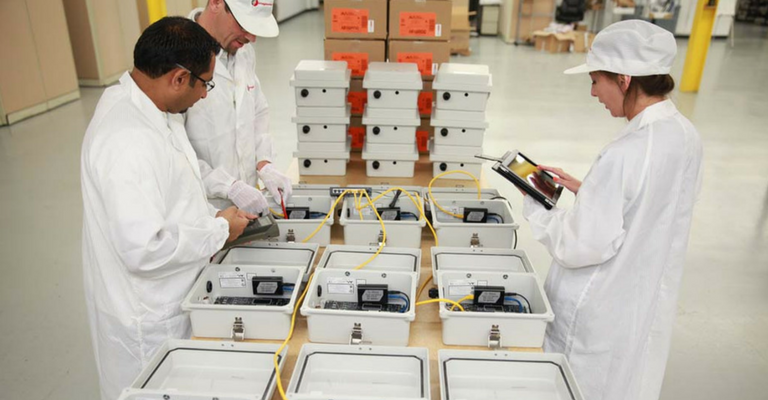For the printed circuit board (PCB) industry, there’s a new recipe stewing when it comes to competing as a leading global manufacturer. Here are two key ingredients:
- Lean manufacturing is essential. Industrial products must be fabricated with a lean supply chain, lean manufacturing, and just-in-time (JIT) production.
- On-time delivery is also vital. The customer must get what it wants when it wants it.
Together, these ingredients help manufacturers – whether they’re fabricating components, sub-assemblies, assemblies, or finished goods – complete the recipe and compete globally.
So how do they do this? Here are a few tips that will help perfect each of these ingredients.
Just-In-Time Production
Build a Culture Centered on JIT
Toyota did just that. Motorola did it, too. IBM also succeeded with it. While each company had its own nomenclature for the concept, they all broadcasted a compelling message that instilled a focus with their workers to reduce any fringe in manufacturing. Toyota called it the “Toyota Production System,” which sought to trim times from raw material inflow to finished product outflow. Motorola named their JIT process “short-cycle manufacturing.” IBM called theirs “continuous flow manufacturing.” In all cases, however, the moniker was part of a mission statement, a credo, a belief system, that was inherent in the company culture. More importantly, it was successful. Today lean manufacturing, which is synonymous with JIT, is more important than ever; the first step is to breed a company culture that embraces it.
Transform Company Culture into a Vendor Culture
Lean manufacturing is a team sport. Finished goods have numerous subcontractors and vendors that provide services, subassemblies, components, and parts. The culture of the company must be extended to these suppliers. They must embrace the goals, principles, and best practices that their customers along the supply chain are seeking and become a part of that solution.
Embrace Technology in the Twenty-First Century Way
Previously, the use of technology referred to manufacturing equipment, automation, and what goes into making the product. Today, it’s much more. Now technology is strategic and deftly used to measure, test, sample, and audit quality. It includes software that tracks, manages, and provides smart visibility and control. As a result, technology must be approached holistically. If it is, you’re well on your way to achieving just-in-time production, better than your competition.
On-Time Delivery
Your Supply Chain is your Value Chain
Understanding this is the foundation of building an on-time delivery system that supports a lean manufacturing model. Yesterday’s manufacturing paid moderate attention to the supply chain and even less to the logistics and transportation components. Today’s supply chain is replete with hot technology, aggressive thinking, and more strategic thinkers. Also in the mix are all sorts of tools, principles, and methods to get the goods there on time and at the right time. It’s not just the usual supply chain that’s a process of all parties involved fulfilling a customer order; it’s now a set of interrelated activities that creates value, which in turn gives you a competitive advantage.
Integration and Agility are your new Watchwords
People, technology, carriers, software, devices, and shippers all must integrate well. Raw material locations and status must be known and seen by production teams long before they enter the flow. Mobile devices used in the warehouse must be linked to larger infrastructures of the transportation and warehouse management systems that enable swift flow and delivery of goods. In addition to integrating, however, they must all be agile. This means robots, workers, and vendors that interact with the production process must be quick, flexible, and able to be redirected and reprogrammed without losing a beat.
Visibility and Control is the Central Nervous System of On-Time Delivery
Smart platforms that provide leaders and decision makers with a way to see and manage are common nowadays. There are many moving parts in lean manufacturing. From materials management to transportation and warehousing, lean manufacturing relies on teams that work together. Their success in working together is monitored by keeping a finger on their pulse. This pulse is the visibility and control that takes shape in many ways: cloud-based software platforms; collaborative efforts across different vendor lines; and an overall way of seeing who’s doing what, when, and where. Visibility and control is at the core of this process. When properly managed, it greatly contributes to achieving the on-time delivery to support lean manufacturing and JIT.
Putting it all Together
The printed circuit board industry is characterized by cost, quality, and speed. Therefore, JIT and on-time delivery must be at the forefront as the industry seeks ways to compete globally. Being able to provide products that customers choose means being aware of what will make a difference when it comes to JIT and on-time delivery—and then doing it.
All too often, those in the PCB industry focus on technology and manufacturing methods while discounting the importance of a corporate culture featuring a forward-thinking philosophy that enables them to build JIT and go lean.
Right now, the outlook for domestic manufacturing is good. This is driven by optimistic trade prospects, a weakened dollar, and some slick tax incentives that just might be the catalyst to make the difference. Firms that are ready to follow a recipe to successfully compete globally and embrace just-in-time production along with on-time delivery will be handsomely rewarded in the months and years to come.

